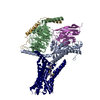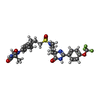[English] 日本語
 Yorodumi
Yorodumi- PDB-8jr9: Small molecule agonist (PCO371) bound to human parathyroid hormon... -
+ Open data
Open data
- Basic information
Basic information
| Entry | Database: PDB / ID: 8jr9 | ||||||
|---|---|---|---|---|---|---|---|
| Title | Small molecule agonist (PCO371) bound to human parathyroid hormone receptor type 1 (PTH1R) | ||||||
 Components Components |
| ||||||
 Keywords Keywords | MEMBRANE PROTEIN / Class B / GPCR | ||||||
| Function / homology |  Function and homology information Function and homology informationparathyroid hormone receptor activity / G protein-coupled peptide receptor activity / Class B/2 (Secretin family receptors) / osteoblast development / positive regulation of inositol phosphate biosynthetic process / bone mineralization / peptide hormone binding / G protein-coupled receptor signaling pathway, coupled to cyclic nucleotide second messenger / chondrocyte differentiation / cell maturation ...parathyroid hormone receptor activity / G protein-coupled peptide receptor activity / Class B/2 (Secretin family receptors) / osteoblast development / positive regulation of inositol phosphate biosynthetic process / bone mineralization / peptide hormone binding / G protein-coupled receptor signaling pathway, coupled to cyclic nucleotide second messenger / chondrocyte differentiation / cell maturation / bone resorption / skeletal system development / Olfactory Signaling Pathway / Activation of the phototransduction cascade / adenylate cyclase-modulating G protein-coupled receptor signaling pathway / G beta:gamma signalling through PLC beta / Presynaptic function of Kainate receptors / Thromboxane signalling through TP receptor / G-protein activation / adenylate cyclase-activating G protein-coupled receptor signaling pathway / G protein-coupled acetylcholine receptor signaling pathway / Activation of G protein gated Potassium channels / Inhibition of voltage gated Ca2+ channels via Gbeta/gamma subunits / Prostacyclin signalling through prostacyclin receptor / Glucagon signaling in metabolic regulation / G beta:gamma signalling through CDC42 / ADP signalling through P2Y purinoceptor 12 / G beta:gamma signalling through BTK / Synthesis, secretion, and inactivation of Glucagon-like Peptide-1 (GLP-1) / Sensory perception of sweet, bitter, and umami (glutamate) taste / photoreceptor disc membrane / Adrenaline,noradrenaline inhibits insulin secretion / Glucagon-type ligand receptors / Vasopressin regulates renal water homeostasis via Aquaporins / intracellular calcium ion homeostasis / G alpha (z) signalling events / cellular response to catecholamine stimulus / Glucagon-like Peptide-1 (GLP1) regulates insulin secretion / ADORA2B mediated anti-inflammatory cytokines production / sensory perception of taste / ADP signalling through P2Y purinoceptor 1 / adenylate cyclase-activating dopamine receptor signaling pathway / G beta:gamma signalling through PI3Kgamma / cellular response to prostaglandin E stimulus / Cooperation of PDCL (PhLP1) and TRiC/CCT in G-protein beta folding / GPER1 signaling / G-protein beta-subunit binding / : / Inactivation, recovery and regulation of the phototransduction cascade / heterotrimeric G-protein complex / G alpha (12/13) signalling events / extracellular vesicle / signaling receptor complex adaptor activity / Thrombin signalling through proteinase activated receptors (PARs) / GTPase binding / retina development in camera-type eye / phospholipase C-activating G protein-coupled receptor signaling pathway / Ca2+ pathway / G alpha (i) signalling events / fibroblast proliferation / G alpha (s) signalling events / G alpha (q) signalling events / basolateral plasma membrane / in utero embryonic development / cell population proliferation / Ras protein signal transduction / Extra-nuclear estrogen signaling / cell surface receptor signaling pathway / receptor complex / apical plasma membrane / G protein-coupled receptor signaling pathway / negative regulation of cell population proliferation / lysosomal membrane / GTPase activity / synapse / positive regulation of cell population proliferation / protein-containing complex binding / signal transduction / protein homodimerization activity / extracellular exosome / membrane / nucleus / plasma membrane / cytoplasm / cytosol Similarity search - Function | ||||||
| Biological species |  Homo sapiens (human) Homo sapiens (human) | ||||||
| Method | ELECTRON MICROSCOPY / single particle reconstruction / cryo EM / Resolution: 2.57 Å | ||||||
 Authors Authors | Zhao, L. / He, Q. / Yuan, Q. / Gu, Y. / He, X. / Shan, H. / Li, J. / Wang, K. / Li, Y. / Hu, W. ...Zhao, L. / He, Q. / Yuan, Q. / Gu, Y. / He, X. / Shan, H. / Li, J. / Wang, K. / Li, Y. / Hu, W. / Wu, K. / Shen, J. / Xu, H.E. | ||||||
| Funding support |  China, 1items China, 1items
| ||||||
 Citation Citation |  Journal: Nature / Year: 2023 Journal: Nature / Year: 2023Title: Conserved class B GPCR activation by a biased intracellular agonist. Authors: Li-Hua Zhao / Qian He / Qingning Yuan / Yimin Gu / Xinheng He / Hong Shan / Junrui Li / Kai Wang / Yang Li / Wen Hu / Kai Wu / Jianhua Shen / H Eric Xu /  Abstract: Class B G-protein-coupled receptors (GPCRs), including glucagon-like peptide 1 receptor (GLP1R) and parathyroid hormone 1 receptor (PTH1R), are important drug targets. Injectable peptide drugs ...Class B G-protein-coupled receptors (GPCRs), including glucagon-like peptide 1 receptor (GLP1R) and parathyroid hormone 1 receptor (PTH1R), are important drug targets. Injectable peptide drugs targeting these receptors have been developed, but orally available small-molecule drugs remain under development. Here we report the high-resolution structure of human PTH1R in complex with the stimulatory G protein (G) and a small-molecule agonist, PCO371, which reveals an unexpected binding mode of PCO371 at the cytoplasmic interface of PTH1R with G. The PCO371-binding site is totally different from all binding sites previously reported for small molecules or peptide ligands in GPCRs. The residues that make up the PCO371-binding pocket are conserved in class B GPCRs, and a single alteration in PTH2R and two residue alterations in GLP1R convert these receptors to respond to PCO371. Functional assays reveal that PCO371 is a G-protein-biased agonist that is defective in promoting PTH1R-mediated arrestin signalling. Together, these results uncover a distinct binding site for designing small-molecule agonists for PTH1R and possibly other members of the class B GPCRs and define a receptor conformation that is specific only for G-protein activation but not arrestin signalling. These insights should facilitate the design of distinct types of class B GPCR small-molecule agonist for various therapeutic indications. | ||||||
| History |
|
- Structure visualization
Structure visualization
| Structure viewer | Molecule:  Molmil Molmil Jmol/JSmol Jmol/JSmol |
|---|
- Downloads & links
Downloads & links
- Download
Download
| PDBx/mmCIF format |  8jr9.cif.gz 8jr9.cif.gz | 219.5 KB | Display |  PDBx/mmCIF format PDBx/mmCIF format |
|---|---|---|---|---|
| PDB format |  pdb8jr9.ent.gz pdb8jr9.ent.gz | 165.6 KB | Display |  PDB format PDB format |
| PDBx/mmJSON format |  8jr9.json.gz 8jr9.json.gz | Tree view |  PDBx/mmJSON format PDBx/mmJSON format | |
| Others |  Other downloads Other downloads |
-Validation report
| Summary document |  8jr9_validation.pdf.gz 8jr9_validation.pdf.gz | 1.2 MB | Display |  wwPDB validaton report wwPDB validaton report |
|---|---|---|---|---|
| Full document |  8jr9_full_validation.pdf.gz 8jr9_full_validation.pdf.gz | 1.2 MB | Display | |
| Data in XML |  8jr9_validation.xml.gz 8jr9_validation.xml.gz | 38.4 KB | Display | |
| Data in CIF |  8jr9_validation.cif.gz 8jr9_validation.cif.gz | 56.1 KB | Display | |
| Arichive directory |  https://data.pdbj.org/pub/pdb/validation_reports/jr/8jr9 https://data.pdbj.org/pub/pdb/validation_reports/jr/8jr9 ftp://data.pdbj.org/pub/pdb/validation_reports/jr/8jr9 ftp://data.pdbj.org/pub/pdb/validation_reports/jr/8jr9 | HTTPS FTP |
-Related structure data
| Related structure data |  36593MC M: map data used to model this data C: citing same article ( |
|---|---|
| Similar structure data | Similarity search - Function & homology  F&H Search F&H Search |
- Links
Links
- Assembly
Assembly
| Deposited unit | 
|
|---|---|
| 1 |
|
- Components
Components
-Guanine nucleotide-binding protein ... , 3 types, 3 molecules ABG
| #1: Protein | Mass: 41879.465 Da / Num. of mol.: 1 Source method: isolated from a genetically manipulated source Source: (gene. exp.)  Homo sapiens (human) / Production host: Homo sapiens (human) / Production host:  |
|---|---|
| #2: Protein | Mass: 38330.793 Da / Num. of mol.: 1 Source method: isolated from a genetically manipulated source Source: (gene. exp.)  Homo sapiens (human) / Gene: GNB1 / Production host: Homo sapiens (human) / Gene: GNB1 / Production host:  |
| #3: Protein | Mass: 7861.143 Da / Num. of mol.: 1 Source method: isolated from a genetically manipulated source Source: (gene. exp.)  Homo sapiens (human) / Gene: GNG2 / Production host: Homo sapiens (human) / Gene: GNG2 / Production host:  |
-Antibody / Protein / Non-polymers , 3 types, 3 molecules NR

| #4: Antibody | Mass: 15343.019 Da / Num. of mol.: 1 Source method: isolated from a genetically manipulated source Source: (gene. exp.)   |
|---|---|
| #5: Protein | Mass: 54783.020 Da / Num. of mol.: 1 Source method: isolated from a genetically manipulated source Source: (gene. exp.)  Homo sapiens (human) / Gene: PTH1R, PTHR, PTHR1 / Production host: Homo sapiens (human) / Gene: PTH1R, PTHR, PTHR1 / Production host:  |
| #6: Chemical | ChemComp-KHF / |
-Details
| Has ligand of interest | Y |
|---|
-Experimental details
-Experiment
| Experiment | Method: ELECTRON MICROSCOPY |
|---|---|
| EM experiment | Aggregation state: PARTICLE / 3D reconstruction method: single particle reconstruction |
- Sample preparation
Sample preparation
| Component | Name: A conserved and druggable pocket in class B G protein coupled receptors for 2 orally active small molecule agonists Type: COMPLEX / Entity ID: #1-#5 / Source: MULTIPLE SOURCES |
|---|---|
| Molecular weight | Value: 0.16 MDa / Experimental value: NO |
| Source (natural) | Organism:  Homo sapiens (human) Homo sapiens (human) |
| Source (recombinant) | Organism:  |
| Buffer solution | pH: 7.04 |
| Specimen | Embedding applied: NO / Shadowing applied: NO / Staining applied: NO / Vitrification applied: YES |
| Vitrification | Cryogen name: ETHANE |
- Electron microscopy imaging
Electron microscopy imaging
| Experimental equipment |  Model: Titan Krios / Image courtesy: FEI Company |
|---|---|
| Microscopy | Model: FEI TITAN KRIOS |
| Electron gun | Electron source:  FIELD EMISSION GUN / Accelerating voltage: 300 kV / Illumination mode: FLOOD BEAM FIELD EMISSION GUN / Accelerating voltage: 300 kV / Illumination mode: FLOOD BEAM |
| Electron lens | Mode: BRIGHT FIELD / Nominal defocus max: 18000 nm / Nominal defocus min: 8000 nm |
| Image recording | Electron dose: 50 e/Å2 / Film or detector model: GATAN K3 (6k x 4k) |
- Processing
Processing
| CTF correction | Type: PHASE FLIPPING AND AMPLITUDE CORRECTION |
|---|---|
| 3D reconstruction | Resolution: 2.57 Å / Resolution method: FSC 0.143 CUT-OFF / Num. of particles: 1099315 / Symmetry type: POINT |
 Movie
Movie Controller
Controller


 PDBj
PDBj



















